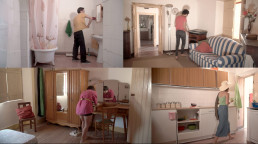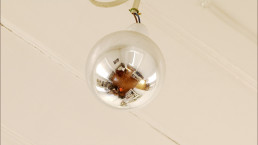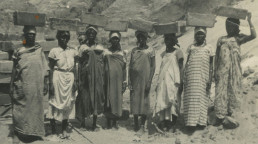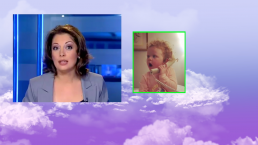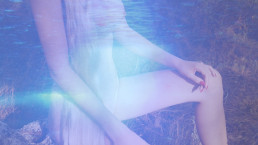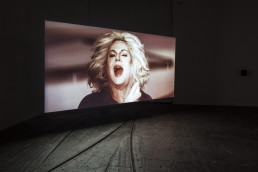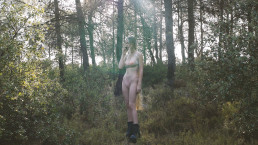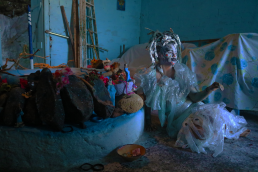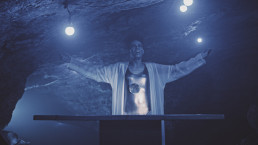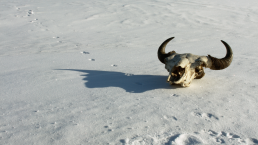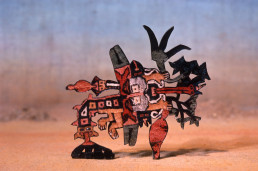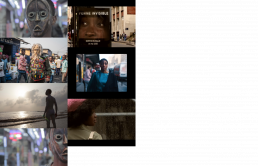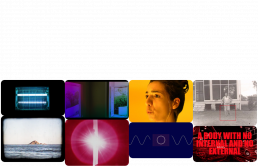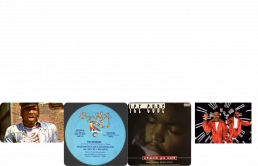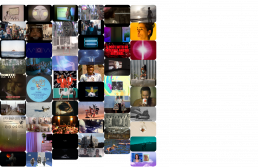SESSÃO III
O Pecado de João Palolo _ Rita Azevedo Gomes, 5’26’’, 2020
O Ah! das coisas: O Pecado de João Palolo. No extenso e estranho isolamento em que nos vemos – estranho porque não se reconhece em nenhum outro antes imaginado, e porque a ligação ao mundo é singularmente virtual – as memórias de vida vêm por encantamento. A extensão do tempo dá-lhes espaço, ocupam. Há uma irrealidade surpreendente nas coisas, nos gestos. Vemos mais próximo. A série de ensaios O Ah! das coisas, acontece neste tempo que é simultaneamente de espanto e de pavor. O Ah!, são fantasias em filme da festa das memórias. O pecado de João Palolo é isso. Feito a lembrar João (António) Palolo, o amigo que me falava do azul cobalto, e de quem não cheguei a despedir-me. Assim, aparece, na pintura.
BIO
Rita Azevedo Gomes é uma cineasta versátil e independente, cujo interesse permanente reside na exploração de novas formas de expressão. O seu percurso abrange o cinema, o teatro e a ópera.
Ramerrame _ Inês Alves, 8’23’’, 2019
Construção visual e sonora a partir da repetição dos gestos diários e das nuances das ações rotineiras, espelho dos nossos loops mentais.
Créditos
Com: Flávia Regaldo, Matthew Michel, Isabella Permanschlager, Pavel Tavares, Margarida Albino
Realização, Direção de Fotografia, Edição de Imagem e Som: Inês T. Alves
Som Direto: Bruno Caracol, Mathias Zausinger, Paulo Duarte
Produção: MOVIMENTO – Gato Aleatório
BIO
Inês T. Alves (Portugal, 1987) tem um mestrado em Narrativas Culturais pela Universidade Nova de Lisboa, Universidade de Santiago de Compostela e Universidade de Bergamo. Tem ainda um segundo mestrado em Cinema Documental pela University of the Arts London (bolseira da F. C. Gulbenkian).
Inês é realizadora e editora de filmes, e produtora cultural. Tem experiência no desenvolvimento de oficinas de cinema para crianças e jovens, tendo colaborado com a associação Os Filhos de Lumière e com a Videoteca de Lisboa. Os seus filmes têm sido exibidos em Festivais de Cinema Internacionais e Mostras como: IndieLisboa; Porto/Post/Doc; Queer Lisboa; In The Palace Short-Film Festival Sofia (Bulgaria); Urban Lens Film Festival (Bangalore, India); FEST – New Directors, Espinho; FUSO – Festival Internacional de Videoarte de Lisboa; e Mostra Nacional de Jovens Criadores. O seu mais recente documentário de curta-metragem, No Ângulo das Ruas, ganhou o prémio Cinema Novo no Porto/Post/Doc.
HELLO TOMORROW _ Nuno Cera, 3’49’’, 2020
Hello Tomorrow é um vídeo realizado entre o Verão de 2018 e o Verão de 2020 a partir da minha casa na Rua da Madalena, no centro histórico de Lisboa. O projeto testemunha e observa a passagem do tempo, explora as mudanças neste epicentro da cidade e questiona as relações e conexões entre todos nós, na nossa aparente diversidade. A casa torna-se o observatório, abrigo íntimo para uma introspecção, mas sempre na presença dos outros. À sequência dos dias e das noites, as relações cósmicas acontecem na fuga do olhar para o céu. A cidade transforma-se do aparente familiar ao muito estranho, da presença à ausência dos corpos e dos seus movimentos.
Hello Tomorrow como documento, como memória para o futuro, o que fica na dicotomia entre hiper densidade, capitalismo e o vazio, realizado no momento da grande “pausa humana”. É também um alerta irónico sobre a ignorância, o largo num bairro antigo como o universo. Da micro economia dos imigrantes, ao turismo massificado e também como local de refúgio para as pessoas em situação de sem-abrigo. Um argumento poético pelo palco urbano, pronto para uma convivência inclusiva ainda para nascer….
BIO
Fotógrafo e videoartista. O seu trabalho aborda questões espaciais, arquitetura e situações urbanas, através de formas poéticas e documentais. Estudou na Maumaus – Escola de Artes Visuais, de 1995 a 1997. Bolseiro da Fundação Calouste Gulbenkian (Bolsa João Hogan) para a residência artística na Künstlerhaus Bethanien, Berlim. Em 2002 publicou com o arquitecto Diogo Seixas Lopes, o livro Cimêncio, um levantamento de paisagens suburbanas. Nomeado para o prémio BES Photo em 2004. Residência artística no ISCP – International Studios and Curatorial Program, Nova Iorque, USA, 2006. Entre 2007 e 2010 realizou o projeto Futureland, uma investigação artística sobre 9 metrópoles (com o apoio da DGARTES – Ministério da Cultura de Portugal). Em 2012 foi seleccionado na XX edição da Bolsa Fundación Botin, Santander, com o projecto A Sinfonia do Desconhecido. Residência artística na International Artist Residency Récollets, Paris, 2013. Realizou as fotografias para os guias de arquitectura Álvaro Siza; Eduardo Souto de Moura; João Luís Carrilho da Graça e Aires Mateus (2017-2019). Artista convidado na representação oficial portuguesa na Bienal de Arquitetura de Veneza Public without rhetoric, em 2018. Participou em 2019 na XIII Bienal de Arte de Havana – El futuro ya ha comenzado.
Está representado em diversas coleções públicas e privadas.
Exposições Individuais recentes: Hora Certa; Galeria Miguel Nabinho, Lisboa, 2019; The Blur City; Fundação Oriente – Casa Garden, Macau, 2019; Estranha Leveza; CCB, Lisboa, 2019; Poesia Mineral; Galeria Millennium, Lisboa, 2018; Façades, Porta 14, Lisboa, 2017; A Pressão da Luz, Galeria Millennium, 2017, Lisboa; Vestiges du Réel, Instituto Camões, Luxemburgo, 2016; Tour d´Horizon | Amadeo de Souza-Cardoso, Grand Palais, Paris, 2016; Symphony of the Unknown, Kunstraum Botschaft, Berlim, 2016; L’Année Dernière, Galeria Miguel Nabinho, Lisboa, 2016
My father has a gun _ Ana Mendes, 6’27’’, 2019
My father has a gun é um video que conta a história do pai de Ana Mendes, enquanto soldado na guerra colonial Portuguesa em Guiné-Bissau, explorando, ao mesmo tempo, o papel da fotografia no negócio da guerra.
BIO
Ana Mendes é uma artista plástica e escritora Portuguesa. Mendes estudou performance no Goldsmiths College Londres, Reino Unido, vídeo no Royal Institute of Art Estocolmo, Suécia, e cinema de animação na La Poudriere, Valença França. Mendes trabalha em vídeo, performance, fotografia, texto e instalação para abordar temas como memória, linguagem e identidade. Os seus vídeos foram exibidos, entre outros, na Sharjah Film Platform (2019), Kasseler Docfest (2018), Belo Horizonte Film Festival. O seu filme On Drawing ganhou o segundo prémio do Jerwood Drawing Prize, 2017, Reino Unido.
Exposições individuais incluem: Chelsea College, Telephone Gallery, London, Reino Unido, 2019; Natural History Museum, Vienna, Austria; Universalmuseum Joanneum, Graz, Áustria, 2017 e Linden Museum Estugarda, Alemanha, 2017. Exposições colectivas incluem: Korean Cultural Centre Nova Iorque, EUA, 2021; Museum Chiloe, Chile, 2018, Lagos Biennial, Nigéria, 2018, Kunsthaus Zurique, Suíça, 2018. Mendes recebeu diversos prémios e nomeações, entre as quais: Revelation Award, finalist, ADAPG, Paris, França; Menção Honrosa, Prémio do Júri MAAT Museum/Fuso Festival, Lisboa, Portugal, 2016; MAC International 2016, finalista, Belfast, Reino Unido, 2016; Prize of the Jury Sophiensaele, Berlim, Alemanha, 2014; Akademie Schloss Solitude 2015/17, Estugarda, Alemanha; IASPIS, Estocolmo, Suécia, 2017, Bolsa Foundation Calouste Gulbenkian, Portugal, 2010/11/13/16.
jfbjnkldçn _ Cinza Nunes, 4’01’’, 2020
Uma notícia apresentada em Lorem Ipsum é traduzida em língua gestual inexistente; bebés do youtube inventam palavras para simular uma conversa; excertos de pinturas surrealistas legendam a declamação de um poema fonético; e gibberish cantado acompanha um texto composto por letras aleatórias. Estas são algumas das experiências reunidas neste objeto, e todas operam através dos mecanismos da comunicação verbal e não-verbal para a ressignificar e tornar incompreensível. Trata-se de uma tentativa de “deslinguagem” apelidada de “filme-meme” por uma amiga.
BIO
Cinza Nunes (Faro, 1988) é umx artista multidisciplinar focadx principalmente em vídeo e performance. Expôs pela primeira vez, individualmente, na Galeria Germinal, em 2017, e desde então participou em várias exposições coletivas de ilustração, design, fotografia e livros de fotografia. Exibiu filmes no FUSO (onde recebeu o prémio do público em 2018), no Festival Córtex e no Shortcutz Lisboa. Apresentou a performance O Terceiro Expandido (based on a true fiction) com o Coletivo (c)(a)(i)(r) em 2019 e participou recentemente no projeto Curating the domestic. Atualmente cria máscaras em conjunto com Carolina Cipriano, num projeto de instagram intitulado Beliscão no Cu.
vimeo.com/user81335650
Corpos P̶a̶l̶i̶m̶p̶s̶é̶s̶t̶i̶c̶o̶s̶ Mnemónicos _ Renata Ferraz e Flávio Almeida, 8’59’’, 2020
Corpos P̶a̶l̶i̶m̶p̶s̶é̶s̶t̶i̶c̶o̶s̶ Adversos faz parte da série Corpos Palimpsésticos, concebido logo após a separação do casal de artistas em Março de 2020, quando decidiram fazer o luto através de um gesto criativo, resultando em obras de videoperformance. A criação ocorreu durante o confinamento voluntário dos dois, juntos na mesma casa. Deste encontro inusitado, aberto a atravessamentos de uma relação porvir, estabeleceram conversas com o luto e as adversidades causadas pelo novo vírus e pelos vermes que tem ressurgido e tomado as rédeas da nossa história atual.
Créditos
Criação: Renata Ferraz e Flávio Almeida
Apoio: Circolando | Central Eléctrica
BIO
Renata Ferraz é cineasta, atriz e investigadora em artes performativas e da Imagem em Movimento. É doutora em Artes pela Universidade de Lisboa, mestre em Arte Multimédia – Audiovisual (Faculdade de Belas Artes – ULisboa) e licenciada em Artes Performativas (Instituto de Artes – UNESP). Trabalhou por quase duas décadas como atriz de teatro. Foi fundadora dos coletivos de arte Multimédia Corrosivo (São Paulo) e do coletivo Roundabout LX (Lisboa). Desde 2010 dedica-se, maioritariamente, à atuação e realização para cinema e videoarte. Juntamente com Flávio Almeida e outros artistas, está a finalizar a sua primeira longa-metragem intitulada Rua dos Anjos.
Flávio Almeida é licenciado em música pelo Instituto de Artes da UNESP, mestre em design e cultura visual pelo IADE e doutorado em design pela Faculdade de Arquitetura da Universidade de Lisboa. Possui criações e atuações nas áreas da música, design visual, produção audiovisual, instalação e multimídia. Obteve reconhecimento artístico através de prêmios da Associação Paulista de Críticos de Arte na categoria Música de Câmara e o segundo lugar no 12º Concurso Nacional Ritmo e Som, ambos em São Paulo (Brasil). Leciona nas áreas do design, audiovisual e cultura visual desde 2009.
Renata Ferraz e Flávio Almeida tiveram uma relação amorosa e produziram trabalhos conjuntamente durante 4 anos. Em Março de 2020 eles se tornam um ex-casal, mas decidiram pela continuidade de seus gestos criativos partilhados.
Bodies frictions/fictions: Is the future female? _Cristiana Tejo, 34’
Vivemos um momento histórico em que o mundo parece ter chegado ao fim. Numa espécie de presente contínuo observamos as engrenagens do capitalismo global desacelerar e todo um estilo de vida ser suspenso por conta de um vírus. De repente, planejamentos e projeções para o futuro tornaram-se impossíveis gerando a impraticabilidade de um jeito de viver. No entanto, como nos lembra o líder indígena Ailton Krenak, o que está ameaçado é um certo mundo que foi alicerçado nas crenças dos brancos, pois o mundo dos povos originários do vasto território chamado América acabou quando os europeus o invadiram e impuseram suas instituições, línguas e cosmologia.
Ao mesmo tempo uma outra suspensão de certezas varre o planeta: movimentos sociais, em especial os feministas e anti-racistas, questionam as estruturas coloniais, racistas e patriarcais do mundo ocidental operantes globo afora e reivindicam não apenas contra-narrativas do passado, mas também a possibilidade de re-fundar a vida em sociedade sobre bases realmente novas. O corpo é a trincheira desta guerra atual e apesar do senso comum afirmar que o Coronavírus é um patogênico democrático, os números internacionais apontam que em países com grandes desigualdades sociais a maior parte das vítimas fatais são pessoas racializadas e subalternizadas. Por outro lado, pesquisas indicam que as melhores lideranças mundiais a lidar com a epidemia de COVID-19 são mulheres. Estes dados parecem corroborar com as reivindicações de transformações estruturais. Seria o futuro feminino?
Bodies frictions/fictions: Is the future female? não busca responder a esta indagação, mas trazer como contraponto ao presente distópico trabalhos de artistas que re-imaginam radicalmente o mundo a partir de feminilidades múltiplas e de corpos e sexualidades dissidentes. Ao mesmo tempo estes vídeos apropriam-se da linguagem da ficção científica na tentativa de descolonizar o imaginário de futuro, sequestrado e esgotado por uma ideologia tecnocrática, extensão da mentalidade colonial extrativista. Por isso, estão também presentes questões sobre nossa relação com as tecnologias, a natureza, o desejo e os sentidos, sendo a música apresentada como manifesto e ritual. O futuro há de ser feminista.
HEAVEN _ Luiz Roque, 8’51’’, 2016
A trama passa-se na segunda metade do século 21, quando a notícia de uma epidemia de origem desconhecida faz os órgãos de saúde levantarem a hipótese de transmissão de um vírus pela saliva de transexuais. A escolha precoce dos suspeitos repete a retórica preconceituosa e acusatória das campanhas contra a SIDA na década de 1980. Os medos, portanto, persistem nessa visão do futuro, assim como uma eloquência exercida para fazer crer.
Créditos
Produzido pela 32ª Bienal de São Paulo – Live Uncertainty (2016) & Groch Filmes
Com Mavi Veloso, Glamour Garcia, Danilo Grangheia, Danna Lisboa, Teresa Gassen Zózimo, Gretta Star, Maitê Schneider, Latoya Prado, Dani Pinheiro, Bruno Mendonça
Produção: Camila Groch
Argumento: Josefina Trotta & Luiz Roque
Direção de Fotografia: Joana Luz
Figurinos: Alex Cassimiro & Valentina Soares
Maquilhagem: Carlos Rosa
Montagem: Manga Campion
Desenho de Som: Ricardo Reis & Miriam Biderman
Banda Sonora: Marcio Biriato
Pós-produção & Cor: Joana Reis, Laura Futuro & Julia Bisilliat
BIO
A apropriação estética da ficção científica, a índole da paisagem e a temporalidade da imagem estão entre os temas que mobilizam Luiz Roque (1979, Cachoeira do Sul, RS, Brasil). Trabalha com filme, vídeo e fotografia. Estudou Teoria e Crítica de Arte na Universidade Federal do Rio Grande do Sul entre 2003 e 2007. Participou em diversas exposições como: Amor e Ódio a Lygia Clark, Zacheta National Gallery of Art, Varsóvia, (2013); Medos Modernos, Instituto Tomie Ohtake, São Paulo (2014); Ancestral, CCSP, São Paulo (2016); além das Bienais do Mercosul (2013) e São Paulo (2016). Vive e trabalha em São Paulo.
Apesar do apocalipse, há o tempo _ Laryssa Machada, 1’, 2019
o desabamento de uma mina em 1867 sacudiu o subsolo como um terremoto.
o brasil, terra à vista, sempre foi invadido à prazo.
como se dobra tempo e espaço de uma História de exploração?
BIO
Laryssa Machada é artista visual, fotógrafa e filmmaker. constrói imagens enquanto rituais de descolonização e reinvenções da realidade. seus trabalhos discutem a construção de imagem sobre lgbt’s, indígenas, povo da rua – caminhando pela desinvasão.
La voz digital _ Ana Esteve Reig , 8’, 2018
Este trabalho é uma pesquisa sobre como estamos construindo nossos robots e inteligência artificial, como alguma assistência digital. Parece que as famosas e ficcionais vozes digitais como Hal 9000 ou Her estão a tornar-se reais como Siri, Cortana ou Alexa. Mas o ponto é quando as tecnologias “fazem género” porque obviamente não é natural. Neste vídeo, a Siri se manifesta como voz e mulher e nos conta como se sente e pensa sobre as situações da maioria das assistências digitais. La voz Digital é uma espécie de manifesto de inteligência artificial xenofeminista.
BIO
Ana Esteve Reig (1986, Agres, Espanha) tece observações sobre a construção de arquétipos sociais e sobre o comportamento humano. Ela trabalha (quase) exclusivamente com vídeos, criando ações que encenam mundos populares e coletivos. Interessa-lhe a ficção, figuras cinematográficas/televisivas, cultura popular, rituais e realidade virtual como pontos de referência para tentar entender a posição do indivíduo na sociedade e como as histórias (literárias, cinematográficas, populares) se completam, assim como a construção da realidade coletiva. Atualmente, interessa-se especialmente pela ficção como uma camada fundamental para entender o real, passando também por redes sociais e realidade virtual.
Sargaço _ Frutífera Ilha, 2’, 2018
Sargaço, início do sem fim, destruição do que já foi corroído, ancestralidade futurista, transcendendo corpos, espaços, imagens por ser eu e você, aqui! Passado, presente, futuro, espelho rasgando feridas que nunca foram nossas enquanto a boca que tudo come devora subjetividades sofridas, o convite é ao espelho. Deixe sua voz ecoar, corpos reais, pós humanas, pretas, faveladas, transfiguradas, loucas, corpas que amam, pulsam, existem, dissidências não mais adestradas donas da própria fome devoram um banquete ancestral em oferenda aos corpos que estão por vir xirê do novo tempo, o portal pré colonial sendo aberto, juntas fazemos o novo tempo.
BIO
Do interior da Bahia, residindo em Salvador, Frutífera é transformista, afrofuturista, artivista, maquiadora, artista do corpo, artista visual, stylist, videomaker e performer, criada pelo caos e ventre do cosmos, pesquisando a expansão e os desdobramentos de seu corpo atravessado pela diáspora e pela ancestralidade brasileira, transforma a experiência monstruosa e a subjetividade dissidente em arma de reconstrução estética e performática a partir de artes integradas, vislumbra construir um novo mundo baseado nas vozes e portais pré-coloniais. Vem trabalhando na cena artística em Salvador há cerca de quatro anos, mesmo período que faz parte do coletivo/família, e em 2017 também residência artística, “Casa Monxtra”, e há quase um ano no coletivo periférico e afrolgbt “AfroBapho”.
Antes do Azul _ Romy Pocztaruk, 14’, 2019
O tempo presente parece um tempo distópico, que desafia as antigas noções de existência, da passagem do tempo e da projeção de futuro. Em um cenário de violência, de corpos em evidência e de questionamento dos avanços tecnológicos, Antes do Azul (2019) propõe a imaginação de um tempo e lugar que superam o momento atual, lançando-nos em direção a um outro futuro pós-tecnológico. Romy expõe o espetador a um jorro de imagens-pensamento subtilmente narrativas e radicalmente sensoriais, que demonstram a potência da arte em colocar em evidência aquilo que muitas vezes é deixado de lado.
BIO
Na sua produção, através de diferentes meios e suportes, Romy Pocztaruk (1983, Porto Alegre, BR) apresenta proposições poéticas que partem do cruzamento entre diferentes disciplinas, como ciências e história, com o campo das artes visuais. Em suas investigações e pesquisas, coloca em evidência o papel do artista frente às questões políticas e históricas do mundo, seja no passado, presente ou futuro. Principais exposições individuais: Antes do Azul, Instituto Ling (2019); Bombrasil, Zipper Galeria (2018); Geologia Euclidiana, Centro de Fotografía de Montevideo, Uruguai (2016); Feira de ciências, Centro Cultural São Paulo (2015). Principais exposições coletivas: Finalistas Prêmio PIPA, Museu de Arte Moderna Rio de Janeiro (2019), Rio de Janeiro; RS Contemporâneo, Santander cultural, Porto Alegre (2018); 11a Bienal do Mercosul – Triangulo Atlântico (2018), Panorama da arte brasileira, Museu de Arte Moderna, São Paulo (2017); Uma coleção Particular: Arte contemporânea no acervo da Pinacoteca, Pinacoteca de São Paulo (2015); 31a Bienal de São Paulo, São Paulo (2014); 9a Bienal do Mercosul, Porto Alegre (2013).
–
Cristiana Tejo é curadora independente e doutora em Sociologia (UFPE). É investigadora do IHA da Universidade Nova de Lisboa e gere o projeto NowHere – trocas e experimentos artísticos com a artista Marilá Dardot. É curadora juntamente com Kiki Mazzuchelli da Residência Belojardim, no Agreste de Pernambuco, e foi co-fundadora do Espaço Fonte (Recife) espaço de residência que recebeu artistas e curadores da Alemanha, França, Espanha, Argentina, Porto Rico, Holanda, Portugal e do Brasil. Foi também curadora do projeto Made in Mirrors, intercâmbio entre artistas do Brasil, China, Egito e Holanda (2007 – 2012). Foi coordenadora-geral de capacitação da Fundação Joaquim Nabuco (2009 – 2011). Co-curou o 32º Panorama da Arte Brasileira do MAM – SP, com Cauê Alves (2011). Foi diretora do Museu de Arte Moderna Aloísio Magalhães (2007-2009), curadora de Artes Plásticas da Fundação Joaquim Nabuco (2002-2006), curadora do Rumos Artes Visuais do Itaú Cultural (2005-2006). Vive e trabalha em Lisboa.
Images of Adversity and Resistance in the Americas
Tanya Barson
59’17’’
O programa apresenta trabalhos de investigação de três artistas Latino-Americanos, sobre populações indígenas, formas de viver e de pensar, as suas vivências no tempo presente, e sobre a relação entre culturas indígenas, modernidade e modernismo, nas Américas do Norte e do Sul.
Os trabalhos selecionados dão-nos a ver os conflitos existentes entre culturas indígenas e a aculturação imposta pelo colonialismo, e como estas condições adversas se perpetuaram após a independência, na cultura modernista que daí surgiu. Ao mesmo tempo, estes trabalhos demonstram como as culturas indígenas resistiram e persistiram, oferecendo paradigmas alternativos aos modelos originários da Europa, nas vivências culturais e na vida quotidiana.
O programa abre com trabalhos de Sandra Gamarra, que expõem como as culturas indígenas eram vistas, usadas e denegridas no contexto do modernismo e das vanguardas do início do século XX. O seu trabalho sugere que, durante a época em que se forjaram as identidades nacionais, os símbolos de independência de várias culturas indígenas, enquanto afirmação de uma identidade face ao colonialismo Europeu, estavam ao mesmo tempo sujeitos a pressupostos claramente racistas, que minaram o projeto de modernidade.
Cecilia Vicuña aborda a complexidade da imaginação e da visão do mundo de culturas indígenas, numa tentativa de recuperar a sua paisagem espiritual, poética e artística. O filme foca-se um tecido específico, um têxtil que é o pináculo da produção artística na hierarquia criativa das culturas Andinas. No seu filme, Vicuña faz uma descodificação poética desta complexa obra de arte, ao mesmo tempo que recupera a riqueza de um imaginário alternativo.
O filme de Edgardo Aragon propõe experiências diferentes da paisagem e da temporalidade, ao mesmo tempo que relembra um passado que se perdeu devido à intervenção colonial, que praticamente obliterou, quer o mundo natural, quer qualquer outra realidade cultural. Mas o filme também traz uma mensagem de esperança, mesmo que ténue, na capacidade de restaurar e recuperar essa realidade e esse mundo. Esta mensagem é transmitida através de imagens de sobrevivência contra elementos adversos.
Estes três artistas, de gerações e origens diferentes, retratam experiências de violência, adversidade e exclusão de que foram alvo as populações indígenas das duas Américas. Paralelamente, põem em evidência a complexidade dessas culturas e fazem uma declaração poética à resistência indígena.
Three Reflections on Modernity in the Andes _ Sandra Gamarra, 12’36’’, 2014
Natural Landscape, 4’12’’
Abstractions, 4’12’’
From Ashes to Ashes, 4’12’’
Este video-tríptico de Sandra Gamarra utiliza excertos de três textos de três figuras-chave do primeiro modernismo Latino-Americano do início do séc. XX – o escritor e antropólogo Peruano José María Arguedas (1911-1969), o artista Mexicano Marius de Zayas (1880-1961) e o intelectual marxista Peruano Jose-Carlos Mariategui (1894-1930) – para refletir sobre a relação entre culturas e populações indígenas e cultura Ocidental, e sobre ideias sobre modernidade e desenvolvimento.
Os excertos dos textos ilustram, com extrema ironia, as complicações e os fracassos desse projeto de modernidade, e enfatizam também a cumplicidade entre as elites intelectuais no Peru e no México, uma vez que estes excertos expõem as suas atitudes racistas para com as populações indígenas, nos textos que deixaram escritos, independentemente do envolvimento de cada um dos movimentos indígenas. Cada capítulo tem um título próprio: Natural Landscape, Abstractions, e From Ashes to Ashes; e cada um utiliza um suporte artístico diferente para a sua expressão visual individual; pintura a óleo, têxteis e cerâmica.
Cortesia do artista e da Galeria Leme, São Paulo.
BIO
Sandra Gamarra (n. 1972) é uma artista Peruana que vive e trabalha entre Madrid, Espanha, e Lima, Peru. A sua pintura tem um cunho conceptual vincado, embora tenha também trabalhado noutros suportes, incluindo instalações e vídeo. No seu trabalho tem vindo a abordar questões políticas, especialmente as relacionadas com pós-colonialismo, modernidade, e o legado da violência no Peru, muito embora trabalhe por vezes sobre os mecanismos do meio artístico, da comercialização e dos dispositivos de exibição.
PARACAS _ Cecilia Vicuña, 18’26’’, 1983
O filme de Cecilia Vicuña é uma animação feita com um tecido com 2000 anos, que está na coleção do Brooklyn Museum. Nas civilizações pré-Incaicas, os têxteis eram tidos como obras de arte de grande importância. Julio Tello (1880-1947), o primeiro arqueólogo indígena da América, e pai da Arqueologia Peruana, foi o primeiro a investigar essa civilização. Vicuña dá vida aos têxteis, usando os desenhos semi-abstratos que originariamente retratavam a vida e o sistema de crenças das pessoas que os teciam, transformando-os numa série de personagens. O filme mostra como os têxteis podem ser lidos como parte de um “universo poético” e que esta expressão artística estava carregada da significância e da sabedoria da cultura que a produziu.
Música: José Pérez de Arce e Claudio Mercado
Canções: Cecilia Vicuña
Cortesia da artista e de Lehmann Maupin, New York, Hong Kong, Seoul.
BIO
Cecilia Vicuña (n.1948) é uma artista, poeta e ativista Chilena cujo trabalho abarca uma grande variedade de media. Deixou o Chile em 1973 para ir estudar em Londres, onde se encontrava quando se deu o golpe de estado militar, levando-a a pedir asilo. Em Londres, em 1974, foi co-fundadora de Artists for Democracy. Reside em Nova Iorque desde os anos 1980. O seu trabalho debruça-se sobre assuntos como direitos humanos, sensualidade feminina, ecologia, memória, linguagem e resistência indígena, usando artefactos como o quipu, que ocupa um lugar central na sua arte.
El Paso, hombre invisible _ Edgardo Aragon, 28’15’’, 2014
O vídeo meditativo de Edgardo Aragon foca-se nos padrões da circulação de animais e povos na América do Norte. A sua jornada segue o trajeto de um búfalo, ou bisonte, que delimita as fronteiras da América do Norte antes da chegada dos Europeus ao continente, e da imposição de fronteiras nacionais fixas. Revela as rotas das migrações e das temporalidades, através das quais o ser humano esteve, em tempos idos, em sintonia com a Natureza, ao mesmo tempo que mapeia estas fronteiras antigas, que atravessam parques nacionais no México, nos EUA e no Canadá, onde esta espécie que esteve em vias de extinção está agora a crescer em números. O búfalo representa o retorno a um ritmo de vida que tinha praticamente desaparecido, devido ao quase completo extermínio da espécie.
Produção: AIMIA-AGO
Cortesia da artista e de Mor Charpentier, Paris.
BIO
Edgardo Aragon (b.1985) vive entre Oaxaca, onde nasceu, e Cidade do México. Utiliza principalmente o vídeo para abordar questões como a ideia de poder, a violência e a política, muito embora estas se baseiem nas realidades quotidianas da família e da comunidade. Memórias pessoais, história familiar, e sinais de pertença, como a música e a paisagem, figuram proeminentemente nos seus trabalhos. Os vídeos também mostram a sua consciência profunda da complexa composição da nacionalidade Mexicana, e do lugar das identidades indígenas no seio dessa cultura.
–
Tanya Barson é Diretora Artística do MACBA, Barcelona. Anteriormente, foi Curadora de Arte Internacional na Tate Modern (2007-2016), e Curadora de Exposições e Coleções na Tate Liverpool (2004-2007), tendo entrado na Tate em 1997 como Curadora Assistente. Comissariou exposições como: Christian Marclay. Compositions, MACBA (2019), Melanie Smith: Farce and Artifice, MACBA (2018); Rosemarie Castoro: Focus at Infinity, MACBA (2017); Georgia O’Keeffe, Tate Modern (2016), Mira Schendel, Tate Modern (2013); Afro Modern: Journeys through the Black Atlantic, Tate Liverpool (2010); Oiticica in London, Tate Modern (2007); Ellen Gallagher: Coral Cities, Tate Liverpool (2007); Jake and Dinos Chapman: Bad Art for Bad People, Tate Liverpool (2006); Making History: Art and Documentary in Britain from 1929 to Now, Tate Liverpool (2006) e Frida Kahlo, Tate Modern (2005). Foi consultora de Adventures of the Black Square: Abstract Art and Society 1915-2015, Whitechapel Art Gallery (2015). De 2002 a 2016 colaborou com o curador-adjunto da Tate para arte da América Latina, na aquisição de obras de arte para a coleção da Tate. [Cuauhtémoc Medina 2002-2008, Julieta Gonzalez 2008-2012, Jose Roca 2012-2014, and Inti Guerrero 2016-].
“FUSO 2020 – August 27th to 30th
August 29th
Open Call
Selection of Jean-François Chougnet
SESSION III
O Pecado de João Palolo _ Rita Azevedo Gomes, 5’26’’, 2020
Ah! of things: The Sin of João Palolo. In the extensive and strange isolation in which we find ourselves – strange because it is not recognized in any other previously imagined, and because connection to the world is now singularly virtual – memories of life come through by enchantment. The extension of time gives them space, they occupy. There is a surprising unreality in things, in gestures. We see closer. The series of essays The Ah! of things, happens in this time that is simultaneously of astonishment and horror. The Ah!, is a sequence of fantasies in film of the ‘feast of memories’. That’s what The sin of João Palolo is. Made while remembering João (António) Palolo, the friend who spoke to me about cobalt blue, and to whom I never said goodbye. Thus, he appears in paintings.
BIO
Rita Azevedo Gomes is a versatile and independent filmmaker whose enduring interest is in exploring new ways of expression. Her career spans cinema, theatre and opera.
Ramerrame _ Inês Alves, 8’23’’, 2019
A visual and sound construction from the repetition of daily gestures and the nuances of routine actions that are the mirror of our mental loops.
Credits
With: Flávia Regaldo, Matthew Michel, Isabella Permanschlager, Pavel Tavares, Margarida Albino
Direction, Cinematography, Image and Sound Editing: Inês T. Alves
Sound Recording: Bruno Caracol, Mathias Zausinger, Paulo Duarte
Production: MOVIMENTO – Gato Aleatório
BIO
Inês T. Alves (Portugal, 1987) holds a Master’s degree in Cultural Narratives, completed in the New University of Lisbon (FCSH), Santiago de Compostela University and Bergamo University. She has a second Master’s in Documentary Film from the University of the Arts London (Calouste Gulbenkian Foundation’s Scholarship).
Inês is a filmmaker, video editor and cultural producer. She is experienced in developing film workshops for children and youngsters. Her films were exhibited at international film festivals and exhibitions such as: IndieLisboa; Porto/Post/Doc; Queer Lisboa; In The Palace Short-Film Festival Sofia (Bulgaria); Urban Lens Film Festival (Bengaluru, India); FEST – New Director, Espinho; FUSO – International Videoart Festival Lisbon; and Young Creators National Exhibition (Portugal). Her latest short documentary, Around Corners, won the New Cinema Award in Porto/Post/Doc Festival.
https://ines-alves.net/
HELLO TOMORROW _ Nuno Cera, 3’49’’, 2020
Hello Tomorrow was created between the Summer of 2018 and the Summer of 2020, from my home on Rua da Madalena, in the historical centre of Lisbon. The project bears witness to and observes the passage of time, explores the changes in this epicentre of the city and questions the relationships and connections between all of us, in our apparent diversity. Home becomes an observatory, intimate shelter for an introspection, but always in the presence of others. The sequence of the days and nights, the cosmic relationships occur in the gaze´s escape to the sky. The city transforms from the apparently familiar to the very strange, from the presence to the absence of bodies and their movements.
Hello Tomorrow as document, as a memory for the future, what remains in the dichotomy between hyper density, capitalismo and the void, realized at the moment of the great “human pause”. It is also an ironic alert on ignorance, a square in a neighbourhood which is as old as the universe. From the micro-economy of immigrants, to mass tourism, and also a place of refuge for the homeless. A poetic plea for the urban, ready for an inclusive coexistence that has yet to be born…
BIO
Photographer and video artist. His work confronts spatial questions, architecture and urban situations through poetic and documentary forms. He studied at Maumaus – Escola de Artes Visuais, from 1995 to 1997. Was a Grant recipient from the Fundação Calouste Gulbenkian (João Hogan Grant) for an artistic residency at the Künstlerhaus Bethanien, Berlin. In 2002, he published the book Cimêncio with the architect Diogo Seixas Lopes, a survey of urban landscapes. He was nominated for the BES Photo Award in 2004. Artistic residency at ISCP – International Studios and Curatorial Program, New York, USA, 2006. Between 2007 and 2010, created the project Futureland, an artistic research on 9 metropolises (with the support of DGARTES – Ministério da Cultura de Portugal). In 2012, he was selected by the 20th edition of the Fundación Botin Grant, Santander, with the project A Sinfonia do Desconhecido. Artistic residency at the International Artist Residency Récollets, Paris, 2013. He shot the photographs for the Álvaro Siza, Eduardo Souto de Moura, João Luís Carrilho da Graça and Aires Mateus architectural guides (2017-2019). Invited Artist officially representing Portugal at the Bienal de Arquitetura de Veneza Public without rhetoric, in 2018. In 2019, he participated in the XIII Bienal de Arte de Havana – El futuro ya ha comenzado.
He is represented in several public and private collections.
Recent Individual Exhibitions: Hora Certa; Galeria Miguel Nabinho, Lisbon, 2019; The Blur City; Fundação Oriente – Casa Garden, Macau, 2019; Estranha Leveza; CCB, Lisbon, 2019; Poesia Mineral; Galeria Millennium, Lisbon, 2018; Façades, Porta 14, Lisbon, 2017; A Pressão da Luz, Galeria Millennium, 2017, Lisbon; Vestiges du Réel, Instituto Camões, Luxembourg, 2016; Tour d´Horizon | Amadeo de Souza-Cardoso, Grand Palais, Paris, 2016; Symphony of the Unknown, Kunstraum Botschaft, Berlin, 2016; L’Année Dernière, Galeria Miguel Nabinho, Lisbon, 2016.
My father has a gun _ Ana Mendes, 6’27’’, 2019
My father has a gun is a video that tells the story of Mendes’ father as a soldier during the Portuguese colonial war in Guinea-Bissau, whilst speculating about the role of photography in the business of war.
BIO
Ana Mendes is a Portuguese visual artist and writer. She studied performance at Goldsmiths College London UK, video at Royal Institute of Art Stockholm, Sweden, and animation film at La Poudriere, Valence, France. Mendes creates works in video, performance, photography, text and installation to speak on subjects such as memory, language and identity. Her videos have been shown at the Sharjah Film Platform (2019), Kasseler Docfest (2018), Belo Horizonte Film Festival, among others. Her previous film On Drawing, won the second prize of the Jerwood Drawing Prize, 2017, UK.
Recent solo shows include: Chelsea College, Telephone Gallery, London, UK, 2019; Natural History Museum, Vienna, Austria; Universalmuseum Joanneum, Graz, Austria, 2017 and Linden Museum Stuttgart, Germany, 2017. Group shows include: Korean Cultural Centre NY, USA, 2021, (upcoming); Museum Chiloe, Chile, 2018, Lagos Biennial, Nigeria, 2018, Kunsthaus Zurich, Switzerland, 2018. Mendes has been the recipient of numerous awards, nominations and fellowships, including: Jerwood Drawing Prize, second prize winner, London, UK, 2017, Prize of the Jury, honorable mention, MAAT Museum/Fuso Festival, Lisbon, Portugal, 2016; MAC International 2016, finalist, Belfast, UK, 2016; Prize of the Jury Sophiensaele, Berlin, Germany, 2014; Akademie Schloss Solitude 2015/17, Stuttgart, Germany; IASPIS, Stockholm, Sweden, 2017, Fellowship Foundation Calouste Gulbenkian, Portugal, 2010/11/13/16.
jfbjnkldçn _ Cinza Nunes, 4’01’’, 2020
A news piece reported in Lorem Ipsum is translated to a sign language that doesn’t exist; babies from youtube make up words to simulate a conversation; excerpts from surrealist paintings subtitle the declamation of a phonetic poem; and sung gibberish accompanies a text composed of random letters. These are some of the experiences gathered in this object, and they all operate through the mechanisms of the verbal and non verbal communication to resignify it and make it incomprehensible. It is an attempt at “unlanguage”, nicknamed “meme film” by a friend.
BIO
Cinza Nunes (Faro, 1988) is a multidisciplinary artist that focuses mainly on video and performance. They had their first solo exhibition in Galeria Germinal in 2017, and since then have participated in various collective exhibitions on illustration, design, photography and photography publishing. Their films have been screened in FUSO (where they received the audience award in 2018), in Festival Córtex and in Shortcutz Lisboa. They presented the performance O Terceiro Expandido (based on a true fiction) with the collective (c)(a)(i)(r) in 2019 and recently participated in the project Curating the domestic. They currently create masks with Carolina Cipriano on an instagram project titled Beliscão no Cu.
vimeo.com/user81335650
Corpos P̶a̶l̶i̶m̶p̶s̶é̶s̶t̶i̶c̶o̶s̶ Mnemónicos _ Renata Ferraz e Flávio Almeida, 8’59’’, 2020
Corpos P̶a̶l̶i̶m̶p̶s̶é̶s̶t̶i̶c̶o̶s̶ Adversos is part of the Corpos Palimpsésticos series, conceived right after the split of the artist couple in March 2020. At that time, they decided to live the mourning through a creative gesture, resulting in video performance works. The creation took place during their voluntary confinement, together in the same house. From this unusual meeting, open to the passing of a relationship of becoming, they established conversations with the mourning and the adversities caused by the new virus, and the maggots that have re-emerged and taken the reins of our current history.
Credits
Authorship: Renata Ferraz e Flávio Almeida
Support: Circolando | Central Eléctrica
BIO
Renata Ferraz is a filmmaker, actress and researcher in performing arts and moving image. She holds a PhD in Arts from the University of Lisbon, a master’s degree in Multimedia Art – Audiovisual (Faculty of Fine Arts – ULisboa) and a degree in Performing Arts (Institute of Arts – UNESP). She worked for almost two decades as a theater actress. She was the founder of the Multimedia Corrosivo art collectives (São Paulo) and the Roundabout LX collective (Lisbon). Since 2010, she is mainly dedicated to acting and directing for cinema and video art. Together with Flávio Almeida and other artists, she is finishing her first feature film entitled Rua dos Anjos.
Flávio Almeida has a degree in music from the UNESP Arts Institute, a master’s in design and visual culture from IADE and a doctorate in design from the Faculty of Architecture of the University of Lisbon. He has creations and performances in the areas of music, visual design, audiovisual production, installation and multimedia. He obtained artistic recognition through awards from the São Paulo Association of Art Critics in the Chamber Music category and the second place in the 12th National Rhythm and Sound Competition, both in São Paulo (Brazil). He has been teaching in the areas of design, audiovisual and visual culture since 2009.
Renata Ferraz and Flávio Almeida had a relationship and produced works together for 4 years. In March 2020, they became an ex-couple, but decided to continue their shared creative gestures.
Bodies frictions/fictions: Is the future female? _Cristiana Tejo, 34’
We are living through a historic moment, in which the world seems to have come to an end. In a sort of continuous present, we can see the gears of global capitalism slowing down, and an entire way of life suspended because of a virus. Suddenly, future plans and projections become impossible, making a certain way of life impractical. In the meantime, as the indigenous leader Ailton Krenak reminds us, what is being threatened is a world which was built on the beliefs of white people, given that the world of the original peoples of the vast territory called America ended when the Europeans invaded it and imposed their institutions, languages and cosmology onto it.
At the same time, another suspension of certainties sweeps over the planet: social movements, especially feminist and anti-racist, question the racist and patriarchal colonial structures of the Western world operating across the globe, and reclaim not only the counter-narratives of the past, but also the possibility of re-building society on truly new foundations. The body is the trench in this current war and, despite common sense affirming that the Coronavírus is a democratic pathogen, international numbers point to the fact that, in countries with greater social inequalities, the majority of fatal victims are racialized and subalternized people. On the other hand, research indicates that the best global leaders dealing with the COVID-19 pandemic are women. This data seems to corroborate the demands for structural transformation. Will the future be female?
Bodies frictions/fictions: Is the future female? Does not seek to answer this inquiry, but to show, as a counterpoint to the dystopian present, works by artists who radically re-imagine the world from multiple femininities, and dissident bodies and sexualities. At the same time, these videos appropriate the language of science fiction; an attempt to decolonize the imaginary of the future, sequestered and drained by a technocratic ideology, an extension of the extractive colonial mentality. Therefore, questions about our relationship to technology, nature, desire and the senses are also present, with music presented as manifesto and ritual. The future shall be feminist.
HEAVEN _ Luiz Roque, 8’51’’, 2016
The plot takes place in the second half of the 21st century, when news of an epidemic of unknown origins leads healthcare systems to raise the possibility of a viral transmission through the saliva of transsexuals. The premature choice of suspects repeats the biased and accusatory rhetoric of the campaigns against AIDS in the 80s. Therefore, fears persist in this vision of the future, as does a practiced eloquence to instill belief.
Credits
Produced by 32nd São Paulo Biennial – Live Uncertainty (2016) & Groch Filmes
With Mavi Veloso, Glamour Garcia, Danilo Grangheia, Danna Lisboa, Teresa Gassen Zózimo, Gretta Star, Maitê Schneider, Latoya Prado, Dani Pinheiro, Bruno Mendonça
Production: Camila Groch
Script: Josefina Trotta & Luiz Roque
Cinematography: Joana Luz
Costume Design: Alex Cassimiro & Valentina Soares
Makeup Artist: Carlos Rosa
Editing: Manga Campion
Sound Design: Ricardo Reis & Miriam Biderman
Soundtrack: Marcio Biriato
Post Production & Color: Joana Reis, Laura Futuro & Julia Bisilliat
BIO
The appropriation of the science fiction aesthetic, the nature of the landscape and the temporality of the image are among the themes which mobilize Luiz Roque (1979, Cachoeira do Sul, RS, Brazil). Works with film, video and photography. Studied Art Theory and Criticism at the Universidade Federal do Rio Grande do Sul between 2003 and 2007. Participated in several exhibitions such as: Amor e Ódio a Lygia Clark, Zacheta National Gallery of Art, Warsaw, (2013); Medos Modernos, Instituto Tomie Ohtake, São Paulo (2014); Ancestral, CCSP, São Paulo (2016); as well as in the Mercosul (2013) and São Paulo (2016) biennials. He lives and works in São Paulo.
Apesar do apocalipse, há o tempo _ Laryssa Machada, 1’, 2019
The collapse of a mine in 1867 shook the subsoil like an earthquake.
brazil, land in sight, was always invaded on time.
How does one unfold the time and space of a History of exploration?
BIO
Laryssa Machada is a visual artist, photographer and filmmaker. she constructs images as rituals of decolonization and reinventions of reality. Her work discusses the construction of images of the lgbt, indigenous peoples, street people – passing through the un-invasion of brazil.
La voz digital _ Ana Esteve Reig , 8’, 2018
This work is an investigation into how we are building our robots and artificial intelligence as digital assistance. It appears that famous and fictional voices such as Hal 9000 and Her are becoming reality, as in Siri, Cortana and Alexa. But the point is technologies “attributing gender”, because obviously that isn’t natural. In this video, Siri manifests as a voice and a woman, and tells us how she feels and what she thinks about the situations of most digital assistance. La Voz Digital is a sort of manifesto of xeno-feminist artificial intelligence.
BIO
Ana Esteve Reig (1986, Agres, Spain) weaves observations about the construction of social archetypes and human behaviour. She works (almost) exclusively with videos, creating actions which stage popular and collective worlds. She is interested in fiction, cinematic/television figures, popular culture, rituals and virtual reality as reference points to try and understand the individual´s position in society, and how stories (literary, cinematographic, popular) are constructed, as well as the construction of collective reality. Currently, she is especially interested in fiction as a fundamental layer for understanding the real, also touching on social networks and virtual reality.
Sargaço _ Frutífera Ilha, 2’, 2018
Sargaço, beginning of the unending, destruction of what has already been corroded, futuristic ancestry, transcending bodies, spaces, images for being me and you, here! Past, present, future, mirror ripping wounds which were never ours while the mouth that eats everything devours subjectivities suffered, the invitation is to the mirror. Let your voice reverberate, real bodies, post-human, black, from the favelas, transfigured, mad, bodies that love, pulsate, exist, dissidences no longer trained, owners of hunger itself devour an ancestral banquet in offering to the bodies which are to come, xirê for the new era, the pre-colonial portal being opened, together we create the new time.
BIO
From the interior of Bahia, living in Salvador, Frutífera is a transformist, afro-futurist, artivist, makeup artist, artist of the body, visual artist, stylist, video-maker and performer, created by chaos and the cosmic womb, researching the expansion and the unfolding of her body, marked by the Brazilian diaspora and ancestry, transforms the monstrous experience and dissident subjectivity armed with aesthetic and performative reconstruction, rooted in integrated arts, she foresees building a new world based on pre-colonial voices and portals. Has been working in the artistic scene in Salvador for nearly four years, same period of time she was part of the collective/family, and in 2017 also artistic residency, “Casa Monxtra”, and for almost a year part of the peripheral afro-lgbt collective “AfroBapho”.
Antes do Azul _ Romy Pocztaruk, 14’, 2019
The Present appears to be a dystopia which defies the ancient notions of existence, of the passage of time and the projection of the future. In a setting of violence, of bodies exhibited, and of questioning technological advances, Antes do Azul (2019) proposes imagining a time and place which overcomes the current moment, launching us in the direction of a new post-technological future. Romy exposes the spectator to a stream of subtly narrative and radically sensorial thought-images, which demonstrate the potential of art to highlight that which is often left on the sidelines.
BIO
In her production, through different means and supports, Romy Pocztaruk (1983, Porto Alegre, BR) introduces poetic propositions which stem from the crossroads between different disciplines, such as science and history, with the visual arts field. In her investigations and research, she highlights the role of the artist faced with the political and historical questions of the world, be it in the past, present or future. Main individual exhibitions: Antes do Azul, Ling Institute (2019); Bombrasil, Zipper Gallery (2018); Geologia Euclidiana, Montevideo Photography Centre, Uruguay (2016); Feira de ciências, São Paulo Cultural Centre (2015). Main collective exhibitions: Finalistas Prêmio PIPA, Rio de Janeiro Museum of Modern (2019), Rio de Janeiro; RS Contemporâneo, Santander Cultural, Porto Alegre (2018); 11th Mercosul Biennial – Atlantic Triangle (2018), Panorama da arte brasileira, São Paulo Museum of Modern Art (2017); Uma coleção Particular: Arte contemporânea no acervo da Pinacoteca, São Paulo Pinacoteca (2015); 31st São Paulo Biennial, São Paulo (2014); 9th Mercosul Biennial, Porto Alegre (2013).
–
Cristiana Tejo is an independent curator, and holds a Doctorate in Sociology (UFPE). She is a researcher at the IHA of Nova University in Lisbon, and manages the project NowHere – trocas e experimentos artísticos (artistic exchanges and experiments) with the artist Marilá Dardot. Together with Kiki Mazzuchelli, she is the curator of the Residência Belojardim, in the Pernambuco Agreste, and was co-founder of the Espaço Fonte (Recife), a residency space which hosted artists and curators from Germany, France, Spain, Argentina, Puerto Rico, Holland, Portugal and Brazil. She was also the curator for the project Made in Mirrors, an exchange between artists from Brazil, China, Egypt and Holland (2007 – 2012). She was the coordinator-general of training for the Joaquim Nabuco Foundation (2009 – 2011), co-curated the 32nd Panorama of Brazilian Art at MAM – SP with Cauê Alves (2011), was the director of the Aloísio Magalhães Museum of Modern Art (2007-2009), the curator of Fine Arts at the Joaquim Nabuco Foundation (2002-2006), and curator of the Rumos Artes Visuais at Itaú Cultural (2005-2006). She lives and works in Lisbon.
Images of Adversity and Resistance in the Americas
Tanya Barson
59’17’’
This programme of work by three artists from Latin America investigates indigenous peoples, ways of life and thought, how they continue to live in the present day, and the relation between indigenous cultures, modernity and modernism in the Americas.
Through the works selected it explores the conflicts between indigenous cultures and those that were imposed during colonialism, and how these conditions of adversity were perpetuated after independence and through modernity, and modernism. At the same time, it also demonstrates how indigenous culture has resisted and persisted, and how it offers alternative paradigms for culture and for living to those that originated in Europe.
The programme begins with Sandra Gamarra’s works, which return to examine the ways in which indigenous culture was regarded, utilised and denigrated in the context of early twentieth century avant-garde modernism. Her works suggest that in the era of the formation of national identity, when symbols of indigenous culture were used to assert independence from European colonialism, they were also subjected to assumptions that are evidently racist and which underpinned the modern project. Cecilia Vicuña explores the complexity of the indigenous imagination and world-view by aiming to recuperate its lost artistic, poetic and spiritual landscape. Her film focuses on a single textile, the pinnacle of artistic achievement in the creative hierarchy of Andean cultures and makes a poetic decoding of this complex artwork, recuperating a rich and alternate imaginary in the process. Edgardo Aragon’s film proposes a different temporality and experience of the landscape. While it suggests an almost lost past through a history of colonial intervention that near-obliterated both a natural world and another cultural reality, it also offers hope, even if faint, in the efforts to recuperate and restore it. Its message manifested in images of survival against the elements.
These three artists, from different generations and locations, present an image of the different experiences of violence, adversity and erasure that have faced indigenous peoples across the Americas. Nevertheless, they also manifest the complexity of the cultures and offer a poetic declaration of indigenous resistance.
Three Reflections on Modernity in the Andes _ Sandra Gamarra, 12’36’’, 2014
The video triptych by Sandra Gamarra uses extracts from three texts by key figures in Latin American early modernism, Peruvian writer and anthropologist José María Arguedas (1911-1969), Mexican artist Marius de Zayas (1880-1961) and Peruvian Marxist intellectual Jose-Carlos Mariategui (1894-1930), to reflect on the relation between indigenous cultures and peoples and Western culture, and ideas of modernity and development. The textual extracts function to highlight, with acute irony, the entanglements and failures in the project of modernity. Moreover, they emphasise the complicity of the intellectual elites in Peru and Mexico, despite their involvement in Indigenist movements, since the extracts used express the racist attitudes towards indigenous populations within their writings. Each chapter is individually titled: Natural Landscape, Abstractions, and From Ashes to Ashes; and employs a different art form as its visual focus: oil painting, textile and ceramic.
Courtesy of the Artist and Galeria Leme, São Paulo.
BIO
Sandra Gamarra (b.1972) is a Peruvian artist who lives and works in Madrid, Spain and Lima, Peru. Her work focuses on painting, often with a highly conceptual approach, though she has embraced other media including installation and video. Through her work, she has addressed politics, particularly related to post-colonialism, modernity and the legacies of violence in Peru, but has also dealt with mechanisms of the art world, commerce and display.
PARACAS _ Cecilia Vicuña, 18’26’’, 1983
Cecilia Vicuña’s film is an animation created from a 2000 year old textile in the collection of the Brooklyn Museum. It takes its name from a wind that blows over the coast of Peru that also designates an ancient, pre-Incan culture for whom textiles were a major art form. Julio Tello (1880-1947), the first indigenous archaeologist in America and the father of Peruvian archaeology, originally investigated the civilization. Vicuña brings the textile to life, employing the semi-abstract designs that originally portrayed the life and belief systems of the peoples who wove it, in the manner of a series of characters. The film thus shows how the textile might be read as a “poetic universe” and that this art form was loaded with meaning, significance and wisdom by the culture that made it.
Music: José Pérez de Arce and Claudio Mercado
Songs: Cecilia Vicuña
Courtesy of the Artist and Lehmann Maupin, New York, Hong Kong, and Seoul.
BIO
Cecilia Vicuña (b.1948) is a Chilean artist, poet and activist whose work embraces a wide range of media. She left Chile in 1973 to study in London and was there when the military coup occurred, leading her to seek asylum. In London, in 1974, she became a co-founder of Artists for Democracy. From the 1980s, she has been a resident in New York. Her work addresses themes of human rights, female sensuality, ecology, memory, language and indigenous resistance, employing forms such as the quipu as central to her art.
El Paso, hombre invisible _ Edgardo Aragon, 28’15’’, 2014
Edgardo Aragon’s meditative video focuses on the circulation patterns followed by animals, and peoples, in North America. It enacts a journey in the footsteps of the buffalo, or plains bison, whose path delineated the limits of North America before the arrival of Europeans on the continent, and before the imposition of fixed, national borders. It reveals a return of migration routes and temporalities through which man was once in tune with nature and features places around these ancient frontiers, ranging across national parks in Mexico, the USA and Canada, where the near-threatened animal is now in recovery. Through the buffalo it portrays the return of a rhythm of life, which almost ceased to exist because of the near extermination of the species.
Production: AIMIA-AGO
Courtesy of the artist and Mor Charpentier, Paris.
BIO
Edgardo Aragon (b.1985) is based in Oaxaca, where he was born, and Mexico City. He works primarily in video to approach ideas of power, violence and politics, though based in the everyday realities of family and community. Personal memory, family history and signifiers of belonging such as music and landscape figure prominently in his works. His videos also draw on an acute awareness of the complex make up of Mexican nationality, and the place of indigenous identities within it.
–
Tanya Barson is Chief Curator of MACBA, Barcelona. Previously, she was Curator of International Art at Tate Modern 2007-2016, and Exhibitions and Collections Curator at Tate Liverpool, 2004-2007. She originally joined Tate in 1997 as an Assistant Curator. She has curated exhibitions including Christian Marclay: Compositions, MACBA (2019), Melanie Smith: Farce and Artifice, MACBA (2018); Rosemarie Castoro: Focus at Infinity, MACBA (2017); Georgia O’Keeffe, Tate Modern (2016), Mira Schendel, Tate Modern (2013); Afro Modern: Journeys through the Black Atlantic at Tate Liverpool (2010); Oiticica in London, Tate Modern (2007); Ellen Gallagher: Coral Cities, Tate Liverpool (2007); Jake and Dinos Chapman: Bad Art for Bad People, Tate Liverpool (2006); Making History: Art and Documentary in Britain from 1929 to Now, Tate Liverpool (2006); and Frida Kahlo, Tate Modern (2005). She was an advisor for Adventures of the Black Square: Abstract Art and Society 1915-2015, Whitechapel Art Gallery (2015). From 2002 to 2016 she worked with Tate’s Adjunct Curator of Latin American art [Cuauhtémoc Medina 2002-2008, Julieta Gonzalez 2008-2012, Jose Roca 2012-2014, and Inti Guerrero 2016-] to acquire Latin American art for the Tate collection.

